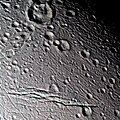Fichier:EN004 Painting on the walls.jpg

Taille de cet aperçu : 600 × 600 pixels. Autres résolutions : 240 × 240 pixels | 480 × 480 pixels | 1 000 × 1 000 pixels.
Fichier d’origine (1 000 × 1 000 pixels, taille du fichier : 442 kio, type MIME : image/jpeg)
Historique du fichier
Cliquer sur une date et heure pour voir le fichier tel qu'il était à ce moment-là.
| Date et heure | Vignette | Dimensions | Utilisateur | Commentaire | |
|---|---|---|---|---|---|
| actuel | 12 janvier 2012 à 03:52 |  | 1 000 × 1 000 (442 kio) | OgreBot | (BOT): Uploading old version of file from en.wikipedia; originally uploaded on 2005-06-03 01:20:58 by Volcanopele |
| 9 août 2005 à 18:37 |  | 600 × 600 (120 kio) | Changcho~commonswiki | Image of Enceladus' surface taken by Cassini (NASA/ESA) on 9 March, 2005. Image shows tectonic features and crater degradation styles. {{PD}} |
Utilisation du fichier
La page suivante utilise ce fichier :
Usage global du fichier
Les autres wikis suivants utilisent ce fichier :
- Utilisation sur als.wikipedia.org
- Utilisation sur ba.wikipedia.org
- Utilisation sur ca.wikipedia.org
- Utilisation sur ca.wikinews.org
- Utilisation sur el.wikipedia.org
- Utilisation sur es.wikinews.org
- Utilisation sur gl.wikipedia.org
- Utilisation sur hu.wikipedia.org
- Utilisation sur it.wikipedia.org
- Utilisation sur pl.wikipedia.org
- Utilisation sur ru.wikipedia.org
- Utilisation sur sk.wikipedia.org
- Utilisation sur sv.wikipedia.org
- Utilisation sur uk.wikipedia.org
- Utilisation sur vi.wikipedia.org
- Utilisation sur zh.wikipedia.org



